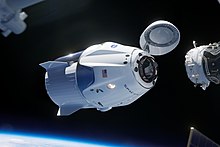SpaceX Crew Dragon capsule docks with International Space Station
Tuesday, March 5, 2019
On Sunday, the SpaceX Crew Dragon capsule successfully docked with the International Space Station in orbit around the Earth. Although the Crew Dragon was carrying only cargo and a mannequin equipped with sensors, this was the first time since the retirement of the space shuttles in 2011 a United States spacecraft capable of carrying humans has made it to the station.

Image: NASA and SpaceX.
Most of the docking process was automatic by the capsule, though the crew of the ISS were able to send the capsule commands to perform simple movements. Previous SpaceX pods have relied on the station's own robotic arm apparatus to take hold of them.
At 2:49 a.m. local time (7:49 a.m. UTC) on Saturday morning, the Crew Dragon was launched via a Falcon 9 rocket from the Kennedy Space Center at Cape Canaveral, Florida in the southeastern United States.
Crew Dragon has enough room for seven people but on this occasion carried only a mannequin, nicknamed "Ripley" for Sigourney Weaver's character in the film Alien. The Crew Dragon is scheduled to remain at the station during the week and return to Earth on Friday.
Bill Gerstenmaier of NASA spoke of the collaboration between his agency and SpaceX: "It's fun working with a new partner that approaches the problem in a slightly different way. They don't carry the same background that we did in NASA, and they don't approach the design exactly the same way we do. [...] And that's cool. I mean, that's really neat."
"To be frank I'm a little emotionally exhausted because that was super stressful. But it worked — so far," SpaceX founder Elon Musk told the press after the launch. "We have to dock to the station, and we have to come back, but so far it's worked. [...] We've passed some of the riskiest items."
The short-term goal of NASA's Commercial Crew Program is to restore NASA's ability to send humans into orbit, which it has been unable to do since retiring the space shuttles in 2011. Longer term, according to NASA administrator Jim Bridenstine, the goal is to render space accessible to many customers and, through commercial competition, do so at a lower cost than the space shuttle missions, which ran about US$1.5 billion apiece. Currently, NASA pays for Russian spacecraft to carry living people, at roughly US$80 million per astronaut.
NASA has selected two astronauts, Doug Hurley and Bob Behnken, for Crew Dragon's first manned mission, which NASA said might take place this summer.
The Boeing airframe company is also collaborating with NASA on human-crewable spacecraft and its Starliner craft is scheduled to undergo flight test this spring. NASA's contract with Boeing is currently valued at US$4.2 billion. The contract with SpaceX is valued at US$2.6 billion.
Last year, SpaceX tested its Falcon Heavy rocket by launching company founder Elon Musk's personal Tesla convertible into space.
Related news
- "SpaceX Falcon Heavy rocket blasts Elon Musk's personal Tesla into solar orbit" — Wikinews, February 7, 2018
Sources
- Jackie Wattles. "SpaceX Crew Dragon docks with the space station in demo flight" — CNN, March 3, 2019
- Associated Press. "SpaceX Crew Dragon docks at International Space Station" — The Guardian, March 3, 2019
- Dave Mosher. "Elon Musk says he'd happily ride SpaceX's new Crew Dragon spaceship — 'I think it's a good vehicle'" — Business Insider, March 2, 2019
- Jackie Wattles. "SpaceX Crew Dragon, built to carry humans, launches demo flight" — CNN, March 2, 2019
- Press Association. "SpaceX Crew Dragon spacecraft launches successfully" — The Guardian, March 2, 2019
- Nell Greenfieldboyce. "SpaceX Readies For Key Test Of Capsule Built To Carry Astronauts Into Space" — NPR, February 28, 2019
